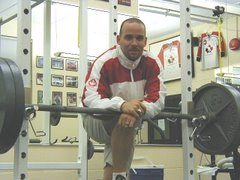Sunday, April 29, 2007
Exercise Description: Single Arm DB Rows
THE SINGLE ARM DB ROW:
Most exercise enthusiasts think they know how to do this one, hands down... which is as good a place to start as any...
Where do you place your hand bracing the bench?
Hand should be gripping the opposite edge of the bench (inside), directly below the opposite chest (so we'll say Left hand on Right edge of bench directly under right chest).
Grabbing the bench any higher will allow you to brace your back in a sway (reverse arch) position - transferring stress to spine segments rather than supporting muscles.
(Basically, while doing an exercise to strengthen your back you are actually teaching it to cheat!)
What about the knee bracing against the bench?
First, this should be the knee on the SAME side as the hand which also bracing the bench (left hand > left knee).
Now that we got that straight, the knee should be directly under the hip (left one), again lower will allow you to sway the back.
Further ahead will feel stronger but thats because if the knee goes more forward than the hip, the angle closes and your hips lower - to an easier leverage point > hence the feeling of being stronger.
Alright, got the left hand on the bench (turned in a grabbing edge), left knee is on bench directly aligned with left hip... now what about Right (other) leg?
Right leg (in this example) should be about a half an arms length out and away from the hip (diagonally). Each person has either bone, tendon or muscle length specifically applied to their own height and weight, so using your own arm length as a guide keeps everything proper in relation to you.
OK, now the actual lift. Just "pull" the weight up and back towards the hip, right?
- Wrong.
Most common mistake is this "bodybuilding" move of exaggerating the range.
Pulling your arm towards your hip changes the muscle selection, function and efficiency.
By doing Single Arm DB Rows it is assumed you are trying to work on the muscles of the upper back (surrounding the shoulder blade), if you want lat work, then go to a different exercise.
Pulling to your hip will engage your lats somewhat, but it will most certainly engage your triceps, rear delts, and therefor traps and pecs to counteract the first two -apparently everything but the Lats (at sufficient intensity).
For the same reasons, dont "extend" your reach forward to "stretch " the Range of Motion. I see this one alot with paddling sports - especially Dragon Boating, paddlers are always trying to "grab more water", a great theory... in the water. Stretching the reach forward basically puts all the poor mechanics discussed above into play. (Again, remember which muscle you are attempting to work on - extending the arm increases the Range of motion alright... of the Lats!)
Pull straight up into arm pit, dont allow the elbow to track away from the body, nothing fancy just lift the darn weight, if you want more complicated - lift a heavier weight.
OK. left arm and leg - check. Right leg out and away - check. Right hand lift directly up straight into armpit - check. Its not so difficult.
Really?... Set up is the easy part, the movement takes more concentration...
Start at the bottom of the arm motion, the stretch most people go forward for is actually straight down > try reaching the dumbbell to the floor.
Easy right? Now try reaching the floor without unlevelling shoulder blades or upper back - you can "extend" your shoulder blade (known as protraction), but dont move chest or upper back angles.
Now shrug the shoulder back into natural position, and even further as if trying to pinch shoulder blades together.
The arm (elbow) hasn't even started to bend yet so while your shoulder has gone through full range, the lift is just beginning.
Keep the tempo that has been set by the shoulder blade movement, bend elbow and pull weight straight up into arm pit.
VERY IMPORTANT - don't change the angle of the upper back or chest at all (they will have remained perfectly square, or parallel) to the bench throughout the movement.
If all the mechanics are applied properly, there is very little movement in the body other than the arm attached to the dumbbell.
Right - anything else?
Executive Summary for the visual/physical learner:
Set up so that spine is flat (parallel to bench) and not rotated at all. Act as though you glasses of water are placed every 4 inches on spine, try lifting the weight full range without spilling any water.
There are still several other things that can be adjusted about this lift, but this is a basic version which most people still have difficulty with.
The information contained in this post are descriptions of exercise mechanics, as implemented in PROformance The Athletes Gym programming. PROformance cannot be held responsible for how this information is used.
Saturday, April 28, 2007
PROformance has a NEW Home...
PROformance has moved ... we will now be located at The Rexall Centre on York University campus.
To all of you who have waited patiently for "some" information over the past 8 weeks, we are proud and pleased to announce our new digs, and look forward to what we can accomplish as the only private High Performance Centre in Toronto to be located within a professional sports facility.
We begin arranging facilities and programs on May 1st, and will be accepting registrations for summer programs starting May1st.
Deadline for Early Bird Summer Registration will be May 19th, after that spaces will be limited!
We are limiting spaces for the summer programs... so don't wait.
Subscribe to:
Posts (Atom)




